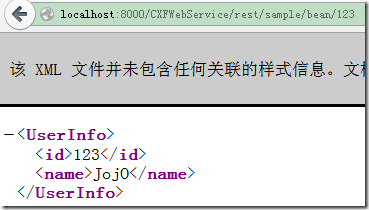这篇文章是承接之前CXF整合Spring的这个项目示例的延伸,所以有很大一部分都是一样的。关于发布CXF WebServer和Spring整合CXF这里就不再多加赘述了。如果你对Spring整合CXF WebService不了解,具体你可以参看这两篇文章:
http://www.cnblogs.com/hoojo/archive/2011/03/30/1999563.html
http://www.cnblogs.com/hoojo/archive/2012/07/13/2590593.html
如果你不了解restful风格的WebService,你可以参考:
http://www.oracle.com/technetwork/articles/javase/index-137171.html
SpringMVC对RESTful的支持:
http://www.cnblogs.com/hoojo/archive/2011/06/10/2077422.html
使用 Jersey框架,搭建RESTful WebService(这个也比较简单)
http://www.ibm.com/developerworks/cn/web/wa-aj-tomcat/
官方文档:http://jersey.java.net/nonav/documentation/latest/user-guide.html#d4e8
其中,比较常用的RESTful框架就有Jersey、Spring REST、CXF RESTful,这些都可以很好的整合Spring框架,发布也相当的简单。且简单、易用、易上手,文档也比较丰富。
开发环境:
System:Windows
JavaEE Server:tomcat6
JavaSDK: jdk6+
IDE:eclipse、MyEclipse 6.6
开发依赖库:
JDK6、 JavaEE5、CXF-2.3.3、Spring 3.0.4
Email:hoojo_@126.com
下面我们就接着http://www.cnblogs.com/hoojo/archive/2011/03/30/1999563.html这篇文章,开始我们CXF RESTful WebService的旅程,enjoy~!^_*
准备工作
首先,你需要添加相关的jar包
其中,jsr331-api-1.1.1.jar是必须的,利用CXF发布REST服务得用到它,在cxf的lib库中可以找到这个jar。
下载地址:http://www.apache.org/dyn/closer.cgi?path=/cxf/2.3.11/apache-cxf-2.3.11.zip
其它的jar包都是非必须的!
JavaEntity
package com.hoo.entity;import java.util.Map;import javax.xml.bind.annotation.XmlRootElement;/*** <b>function:</b> MapBean 封装Map集合元素* @author hoojo* @createDate 2012-7-20 下午01:22:31* @file MapBean.java* @package com.hoo.entity* @project CXFWebService* @blog http://blog.csdn.net/IBM_hoojo* @email hoojo_@126.com* @version 1.0*/@XmlRootElementpublic class MapBean {private Map<String, User> map;//@XmlElement(type = User.class)public Map<String, User> getMap() {return map;}public void setMap(Map<String, User> map) {this.map = map;}}package com.hoo.entity;import java.util.HashMap;import java.util.List;import javax.xml.bind.annotation.XmlRootElement;/*** <b>function:</b> Users Entity* @author hoojo* @createDate 2011-3-18 上午09:27:31* @file Users.java* @package com.hoo.entity* @project CXFWebService* @blog http://blog.csdn.net/IBM_hoojo* @email hoojo_@126.com* @version 1.0*/@XmlRootElement(name = "UserInfos")public class Users {private List<User> users;private User[] userArr;private HashMap<String, User> maps;// getter/setter}package com.hoo.entity;import java.io.Serializable;import javax.xml.bind.annotation.XmlRootElement;/*** <b>function:</b>User Entity* @author hoojo* @createDate Dec 16, 2010 10:20:02 PM* @file User.java* @package com.hoo.entity* @project AxisWebService* @blog http://blog.csdn.net/IBM_hoojo* @email hoojo_@126.com* @version 1.0*/@XmlRootElement(name = "UserInfo")public class User implements Serializable {private static final long serialVersionUID = 677484458789332877L;private int id;private String name;private String email;private String address;//getter/setter@Overridepublic String toString() {return this.id + "#" + this.name + "#" + this.email + "#" + this.address;}}
一、定义你的WebService的接口RESTSample.java,代码如下
package com.hoo.service;import java.io.IOException;import javax.servlet.http.HttpServletRequest;import javax.servlet.http.HttpServletResponse;import javax.ws.rs.Consumes;import javax.ws.rs.DELETE;import javax.ws.rs.GET;import javax.ws.rs.POST;import javax.ws.rs.PUT;import javax.ws.rs.Path;import javax.ws.rs.PathParam;import javax.ws.rs.Produces;import javax.ws.rs.core.Context;import javax.ws.rs.core.MediaType;import com.hoo.entity.MapBean;import com.hoo.entity.User;import com.hoo.entity.Users;/* 注释(Annotation):在 javax.ws.rs.* 中定义,是 JAX-RS (JSR 311) 规范的一部分。 @Path:定义资源基 URI。由上下文根和主机名组成,资源标识符类似于 http://localhost:8080/RESTful/rest/hello。 @GET:这意味着以下方法可以响应 HTTP GET 方法。 @Produces:以纯文本方式定义响应内容 MIME 类型。 @Context: 使用该注释注入上下文对象,比如 Request、Response、UriInfo、ServletContext 等。 @Path("{contact}"):这是 @Path 注释,与根路径 “/contacts” 结合形成子资源的 URI。 @PathParam("contact"):该注释将参数注入方法参数的路径,在本例中就是联系人 id。其他可用的注释有 @FormParam、@QueryParam 等。 @Produces:响应支持多个 MIME 类型。在本例和上一个示例中,APPLICATION/XML 将是默认的 MIME 类型。 *//** * <b>function:</b> CXF RESTful风格WebService * @author hoojo * @createDate 2012-7-20 下午01:23:04 * @file RESTSampleSource.java * @package com.hoo.service * @project CXFWebService * @blog http://blog.csdn.net/IBM_hoojo * @email hoojo_@126.com * @version 1.0 */@Path(value = "/sample")public interface RESTSample {
@GET
@Produces(MediaType.TEXT_PLAIN)
public String doGet();@GET
@Produces(MediaType.TEXT_PLAIN)
@Path("/request/{param}")public String doRequest(@PathParam("param") String param,
@Context HttpServletRequest servletRequest, @Context HttpServletResponse servletResponse);
@GET
@Path("/bean/{id}") @Produces({ MediaType.APPLICATION_XML, MediaType.APPLICATION_JSON })public User getBean(@PathParam("id") int id);
@GET
@Path("/list") @Produces({ MediaType.APPLICATION_JSON, MediaType.APPLICATION_XML }) public Users getList();@GET
@Path("/map") @Produces({ MediaType.APPLICATION_XML, MediaType.APPLICATION_JSON }) public MapBean getMap(); /* @Consumes:声明该方法使用 HTML FORM。 @FormParam:注入该方法的 HTML 属性确定的表单输入。 @Response.created(uri).build(): 构建新的 URI 用于新创建的联系人(/contacts/{id})并设置响应代码(201/created)。 您可以使用 http://localhost:8080/Jersey/rest/contacts/<id> 访问新联系人 */@POST
@Path("/postData")public User postData(User user) throws IOException;
@PUT
@Path("/putData/{id}")@Consumes(MediaType.APPLICATION_XML)
public User putData(@PathParam("id") int id, User user);
@DELETE
@Path("/removeData/{id}")public void deleteData(@PathParam("id") int id);
}
二、RESTSample接口的实现,这里我们只是简单的实现下,并不是涉及实际的具体业务
package com.hoo.service;import java.io.IOException;import java.util.ArrayList;import java.util.HashMap;import java.util.List;import java.util.Map;import javax.servlet.http.HttpServletRequest;import javax.servlet.http.HttpServletResponse;import javax.ws.rs.DELETE;import javax.ws.rs.GET;import javax.ws.rs.POST;import javax.ws.rs.PUT;import javax.ws.rs.Path;import javax.ws.rs.PathParam;import javax.ws.rs.Produces;import javax.ws.rs.core.Context;import javax.ws.rs.core.MediaType;import javax.ws.rs.core.Request;import javax.ws.rs.core.UriInfo;import com.hoo.entity.MapBean;import com.hoo.entity.User;import com.hoo.entity.Users;/* 注释(Annotation):在 javax.ws.rs.* 中定义,是 JAX-RS (JSR 311) 规范的一部分。 @Path:定义资源基 URI。由上下文根和主机名组成,资源标识符类似于 http://localhost:8080/RESTful/rest/hello。 @GET:这意味着以下方法可以响应 HTTP GET 方法。 @Produces:以纯文本方式定义响应内容 MIME 类型。 @Context: 使用该注释注入上下文对象,比如 Request、Response、UriInfo、ServletContext 等。 @Path("{contact}"):这是 @Path 注释,与根路径 “/contacts” 结合形成子资源的 URI。 @PathParam("contact"):该注释将参数注入方法参数的路径,在本例中就是联系人 id。其他可用的注释有 @FormParam、@QueryParam 等。 @Produces:响应支持多个 MIME 类型。在本例和上一个示例中,APPLICATION/XML 将是默认的 MIME 类型。 *//** * <b>function:</b> CXF RESTful风格WebService * @author hoojo * @createDate 2012-7-20 下午01:23:04 * @file RESTSampleSource.java * @package com.hoo.service * @project CXFWebService * @blog http://blog.csdn.net/IBM_hoojo * @email hoojo_@126.com * @version 1.0 */@Path(value = "/sample")public class RESTSampleSource implements RESTSample {
@Context
private UriInfo uriInfo;@Context
private Request request;@GET
@Produces(MediaType.TEXT_PLAIN)
public String doGet() {return "this is get rest request";
}
@GET
@Produces(MediaType.TEXT_PLAIN)
@Path("/request/{param}")public String doRequest(@PathParam("param") String param,
@Context HttpServletRequest servletRequest, @Context HttpServletResponse servletResponse) {System.out.println(servletRequest);
System.out.println(servletResponse);
System.out.println(servletRequest.getParameter("param"));System.out.println(servletRequest.getContentType());
System.out.println(servletResponse.getCharacterEncoding());
System.out.println(servletResponse.getContentType());
return "success";
}
@GET
@Path("/bean/{id}") @Produces({ MediaType.APPLICATION_XML, MediaType.APPLICATION_JSON })public User getBean(@PathParam("id") int id) {
System.out.println("####getBean#####"); System.out.println("id:" + id); System.out.println("Method:" + request.getMethod()); System.out.println("uri:" + uriInfo.getPath());System.out.println(uriInfo.getPathParameters());
User user = new User();user.setId(id);
user.setName("JojO"); return user;}
@GET
@Path("/list") @Produces({ MediaType.APPLICATION_JSON, MediaType.APPLICATION_XML }) public Users getList() { System.out.println("####getList#####"); System.out.println("Method:" + request.getMethod()); System.out.println("uri:" + uriInfo.getPath());System.out.println(uriInfo.getPathParameters());
List<User> list = new ArrayList<User>();User user = null;
for (int i = 0; i < 4;i ++) {
user = new User();user.setId(i);
user.setName("JojO-" + i);list.add(user);
}
Users users = new Users();users.setUsers(list);
return users;}
@GET
@Path("/map") @Produces({ MediaType.APPLICATION_XML, MediaType.APPLICATION_JSON }) public MapBean getMap() { System.out.println("####getMap#####"); System.out.println("Method:" + request.getMethod()); System.out.println("uri:" + uriInfo.getPath());System.out.println(uriInfo.getPathParameters());
Map<String, User> map = new HashMap<String, User>();User user = null;
for (int i = 0; i < 4;i ++) {
user = new User();user.setId(i);
user.setName("JojO-" + i); map.put("key-" + i, user);}
MapBean bean = new MapBean();bean.setMap(map);
return bean;}
/* @Consumes:声明该方法使用 HTML FORM。 @FormParam:注入该方法的 HTML 属性确定的表单输入。 @Response.created(uri).build(): 构建新的 URI 用于新创建的联系人(/contacts/{id})并设置响应代码(201/created)。 您可以使用 http://localhost:8080/Jersey/rest/contacts/<id> 访问新联系人 */@POST
@Path("/postData") @Produces({ MediaType.APPLICATION_XML, MediaType.APPLICATION_JSON })public User postData(User user) throws IOException {
System.out.println(user);
user.setName("jojo##12321321"); return user;}
@PUT
@Path("/putData/{id}") @Produces({ MediaType.APPLICATION_XML })public User putData(@PathParam("id") int id, User user) {
System.out.println("#####putData#####");System.out.println(user);
user.setId(id);
user.setAddress("hoojo#gz"); user.setEmail("hoojo_@126.com"); user.setName("hoojo");System.out.println(user);
return user;}
@DELETE
@Path("/removeData/{id}")public void deleteData(@PathParam("id") int id) {
System.out.println("#######deleteData#######" + id);}
}
<?xml version="1.0" encoding="UTF-8"?><beans xmlns="http://www.springframework.org/schema/beans"xmlns:context="http://www.springframework.org/schema/context"xmlns:jaxws="http://cxf.apache.org/jaxws"xmlns:jaxrs="http://cxf.apache.org/jaxrs"xmlns:xsi="http://www.w3.org/2001/XMLSchema-instance"xsi:schemaLocation="http://www.springframework.org/schema/beanshttp://www.springframework.org/schema/beans/spring-beans-3.0.xsdhttp://www.springframework.org/schema/contexthttp://www.springframework.org/schema/context/spring-context-3.0.xsdhttp://cxf.apache.org/jaxwshttp://cxf.apache.org/schemas/jaxws.xsdhttp://cxf.apache.org/jaxrshttp://cxf.apache.org/schemas/jaxrs.xsd">特别注意上面加粗带下划线的部分,这是新增加的配置。我们发布restful WebService需要用到它。然后在配置文件中添加如下配置<import resource="classpath:META-INF/cxf/cxf.xml"/><import resource="classpath:META-INF/cxf/cxf-extension-soap.xml"/><import resource="classpath:META-INF/cxf/cxf-servlet.xml"/><bean id="restSample" class="com.hoo.service.RESTSampleSource"/><!-- 这里的地址很重要,客户端需要通过这个地址来访问WebService --><jaxrs:server id="restServiceContainer" address="/rest"><jaxrs:serviceBeans><ref bean="restSample" /></jaxrs:serviceBeans><jaxrs:extensionMappings><entry key="json" value="application/json" /><entry key="xml" value="application/xml" /></jaxrs:extensionMappings><jaxrs:languageMappings><entry key="en" value="en-gb"/></jaxrs:languageMappings></jaxrs:server>这样服务器端就完成了CXF RESTful WebService的发布,启动你的tomcat。然后在浏览器中服务地址:http://localhost:8000/CXFWebService/ (其实这里请求的是CXFServlet,你可以看看上一篇Spring整合CXF文章的web.xml的配置)
你就可以看到我们这里刚刚发布的RESTSample rest的WebService
你也可以看看里面的xml,也就是WebService的wsdl文件内容。我们找一个GET方式的WebService的方法,在浏览器中调用一下试试
http://localhost:8000/CXFWebService/rest/sample/bean/123
这个url对应到下面这个方法
@GET@Path("/bean/{id}")@Produces({ MediaType.APPLICATION_XML, MediaType.APPLICATION_JSON })public User getBean(@PathParam("id") int id)结果如下
一篇xml文档内容。
四、编写客户端代码,调用RESTful WebService
package com.hoo.client;import java.io.IOException;import javax.ws.rs.core.MediaType;import org.apache.cxf.jaxrs.client.WebClient;import org.junit.After;import org.junit.Before;import org.junit.Test;import org.springframework.context.ApplicationContext;import org.springframework.context.support.ClassPathXmlApplicationContext;import com.hoo.entity.MapBean;import com.hoo.entity.User;import com.hoo.entity.Users;import com.hoo.service.RESTSample;/*** <b>function:</b> RESTful风格WebService* @author hoojo* @createDate 2012-7-20 下午03:31:03* @file RSETServiceClient.java* @package com.hoo.client* @project CXFWebService* @blog http://blog.csdn.net/IBM_hoojo* @email hoojo_@126.com* @version 1.0*/public class RSETServiceClient {private static WebClient client;@Beforepublic void init() {// 手动创建webClient对象,注意这里的地址是发布的那个/rest地址//String url = "http://localhost:8000/CXFWebService/rest/";//client = WebClient.create(url);// 从Spring Ioc容器中拿webClient对象ApplicationContext ctx = new ClassPathXmlApplicationContext("applicationContext-client.xml");client = ctx.getBean("webClient", WebClient.class);}@Afterpublic void destory(){}@Testpublic void testGet() {System.out.println(client.path("sample").accept(MediaType.TEXT_PLAIN).get(String.class));}@Testpublic void testRequest() {System.out.println(client.path("sample/request/234234").accept(MediaType.TEXT_PLAIN).get(String.class));}@Testpublic void testBean() {User user = client.path("sample/bean/{id}", 25).accept(MediaType.APPLICATION_XML).get(User.class);System.out.println(user);}@Testpublic void testList() {System.out.println(client.path("sample/list").accept(MediaType.APPLICATION_XML).get(Users.class).getUsers());}@Testpublic void testMap() {System.out.println(client.path("sample/map").accept(MediaType.APPLICATION_XML).get(MapBean.class).getMap());}@Testpublic void testDeleteData() {client.path("sample/removeData/23").delete();}@Testpublic void testPostData() {User user = new User();user.setId(21432134);user.setAddress("hoojo#gz");user.setEmail("hoojo_@126.com");user.setName("hoojo");System.out.println(client.path("sample/postData").accept(MediaType.APPLICATION_XML).post(user, User.class));}@Testpublic void testPutData() {User user = new User();user.setId(21432134);System.out.println(client.path("sample/putData/1").accept(MediaType.APPLICATION_XML).put(user).getEntity());}}如果你喜欢用Spring的方式,还需要在applicationContext-client.xml中增加如下配置<?xml version="1.0" encoding="UTF-8"?><beans xmlns="http://www.springframework.org/schema/beans"xmlns:context="http://www.springframework.org/schema/context"xmlns:jaxws="http://cxf.apache.org/jaxws"xmlns:xsi="http://www.w3.org/2001/XMLSchema-instance"xsi:schemaLocation="http://www.springframework.org/schema/beanshttp://www.springframework.org/schema/beans/spring-beans-3.0.xsdhttp://www.springframework.org/schema/contexthttp://www.springframework.org/schema/context/spring-context-3.0.xsdhttp://cxf.apache.org/jaxwshttp://cxf.apache.org/schemas/jaxws.xsd"><bean id="webClient" class="org.apache.cxf.jaxrs.client.WebClient" factory-method="create"><constructor-arg type="java.lang.String" value="http://localhost:8000/CXFWebService/rest/" /></bean></beans>这种是利用WebClient对象来调用WebService,还有一种方法也可以调用WebService,代码如下:
// 手动创建//RESTSample sample = JAXRSClientFactory.create("http://localhost:8000/CXFWebService/rest", RESTSample.class);// 从Spring Ioc容器中拿webClient对象ApplicationContext ctx = new ClassPathXmlApplicationContext("applicationContext-client.xml");RESTSample sample = ctx.getBean("restSampleBean", RESTSample.class);System.out.println(sample);System.out.println(sample.doGet());//System.out.println(sample.doRequest("haha", null, null));System.out.println(sample.getBean(22));System.out.println(sample.getList());System.out.println(sample.getMap().getMap());User user = new User();user.setId(21432134);user.setAddress("hoojo#gz");user.setEmail("hoojo_@126.com");user.setName("hoojo");System.out.println(sample.postData(user));System.out.println(sample.putData(111, user));sample.deleteData(2);这种方式相对比WebClient要简单,直接使用接口中的方法即可。同样如果你要整合到Spring可以在applicationContext-client.xml中增加配置如下:
<bean id="restSampleBean" class="org.apache.cxf.jaxrs.client.JAXRSClientFactory" factory-method="create"><constructor-arg type="java.lang.String" value="http://localhost:8000/CXFWebService/rest/" /><constructor-arg type="java.lang.Class" value="com.hoo.service.RESTSample" /></bean>执行以上方法可以看到控制台打印结果如下:
client consoleorg.apache.cxf.jaxrs.client.ClientProxyImpl@1cf7491this is get rest request22#JojO#null#nullcom.hoo.entity.Users@16eb6bc{key-0=0#JojO-0#null#null, key-1=1#JojO-1#null#null, key-2=2#JojO-2#null#null, key-3=3#JojO-3#null#null}21432134#jojo##12321321#hoojo_@126.com#hoojo#gz111#hoojo#hoojo_@126.com#hoojo#gzserver console####getBean#####id:22Method:GETuri:sample/bean/22{id=[22]}####getList#####Method:GETuri:sample/list{}####getMap#####Method:GETuri:sample/map{}21432134#hoojo#hoojo_@126.com#hoojo#gz#####putData#####21432134#hoojo#hoojo_@126.com#hoojo#gz111#hoojo#hoojo_@126.com#hoojo#gz#######deleteData#######2就这样,整合restful WebService成功。


